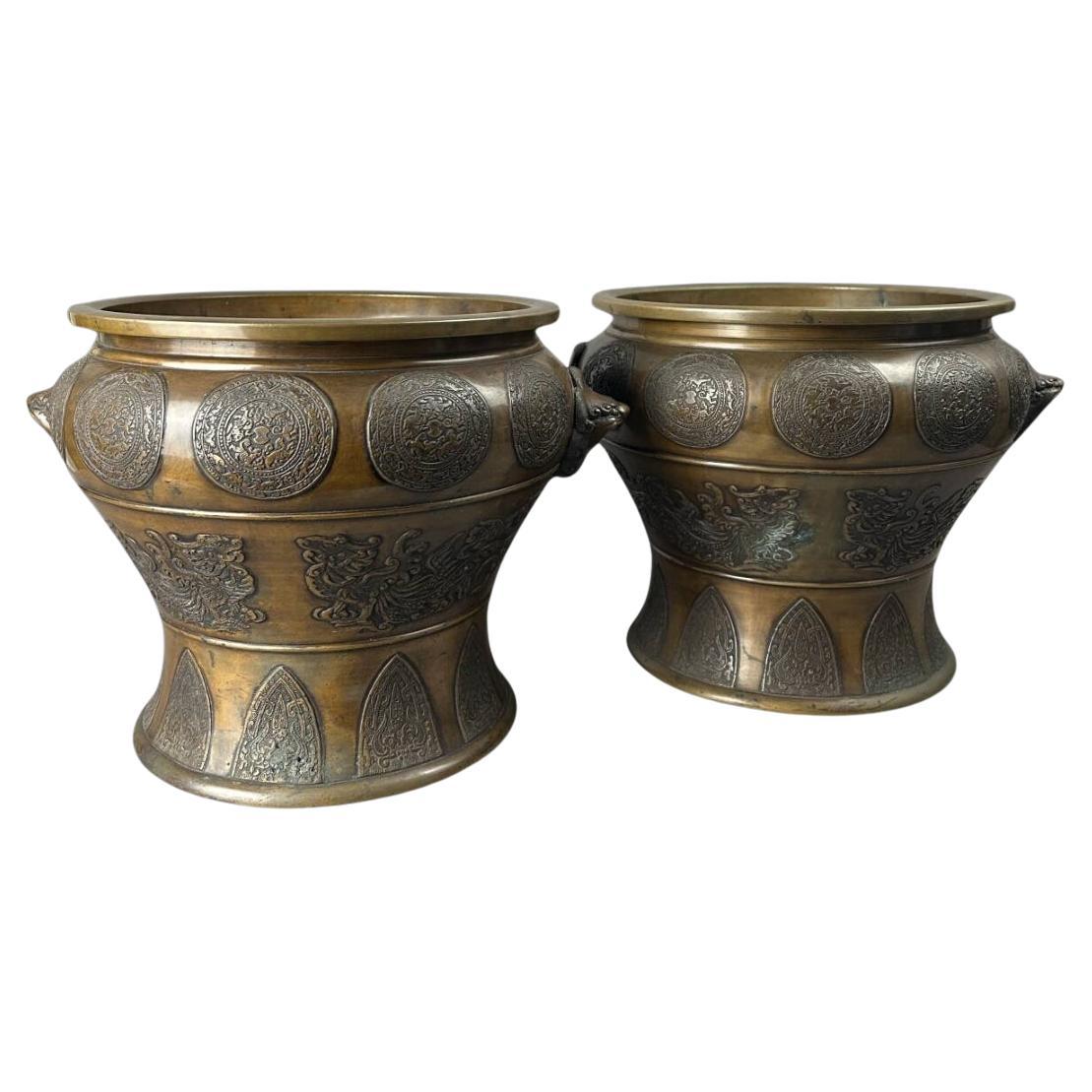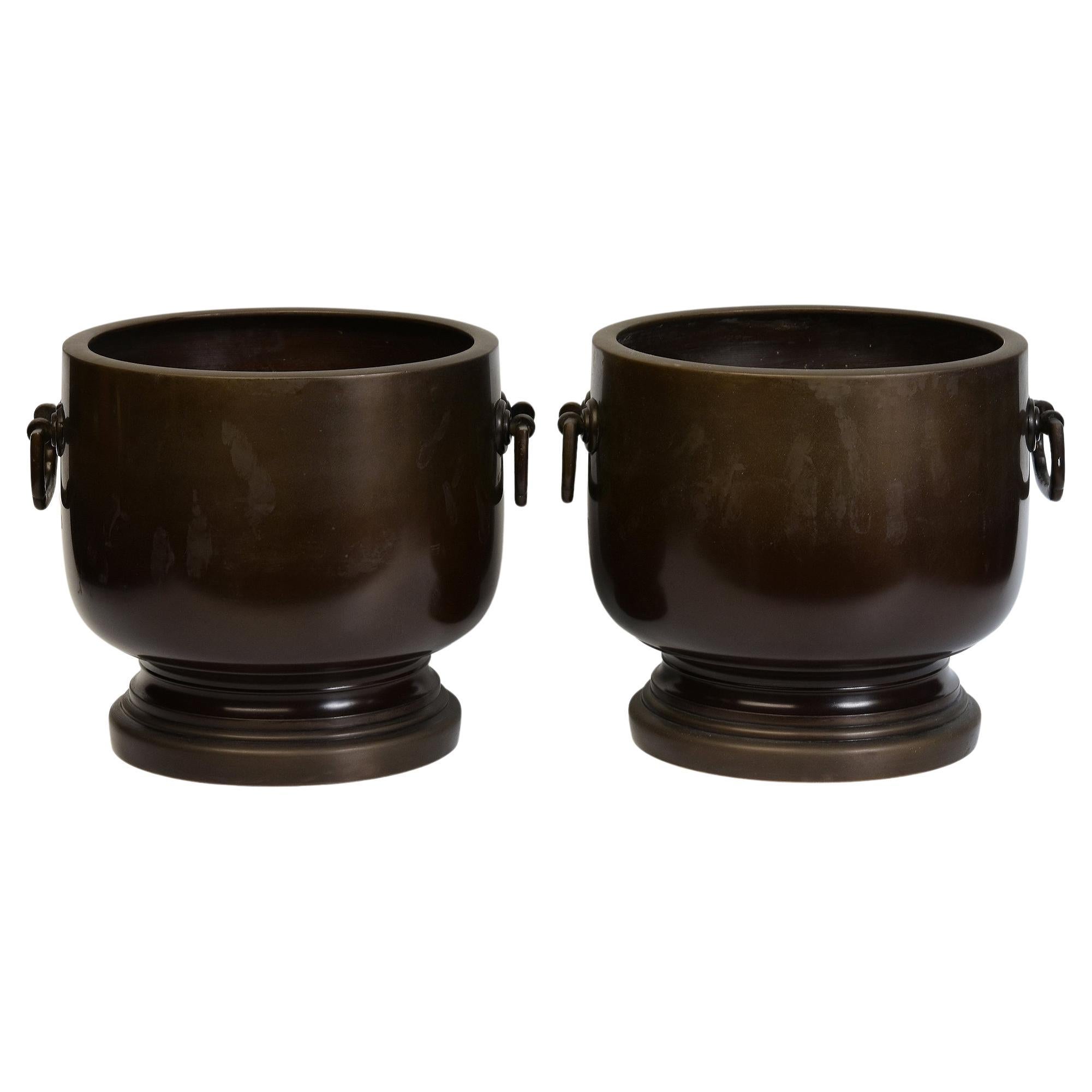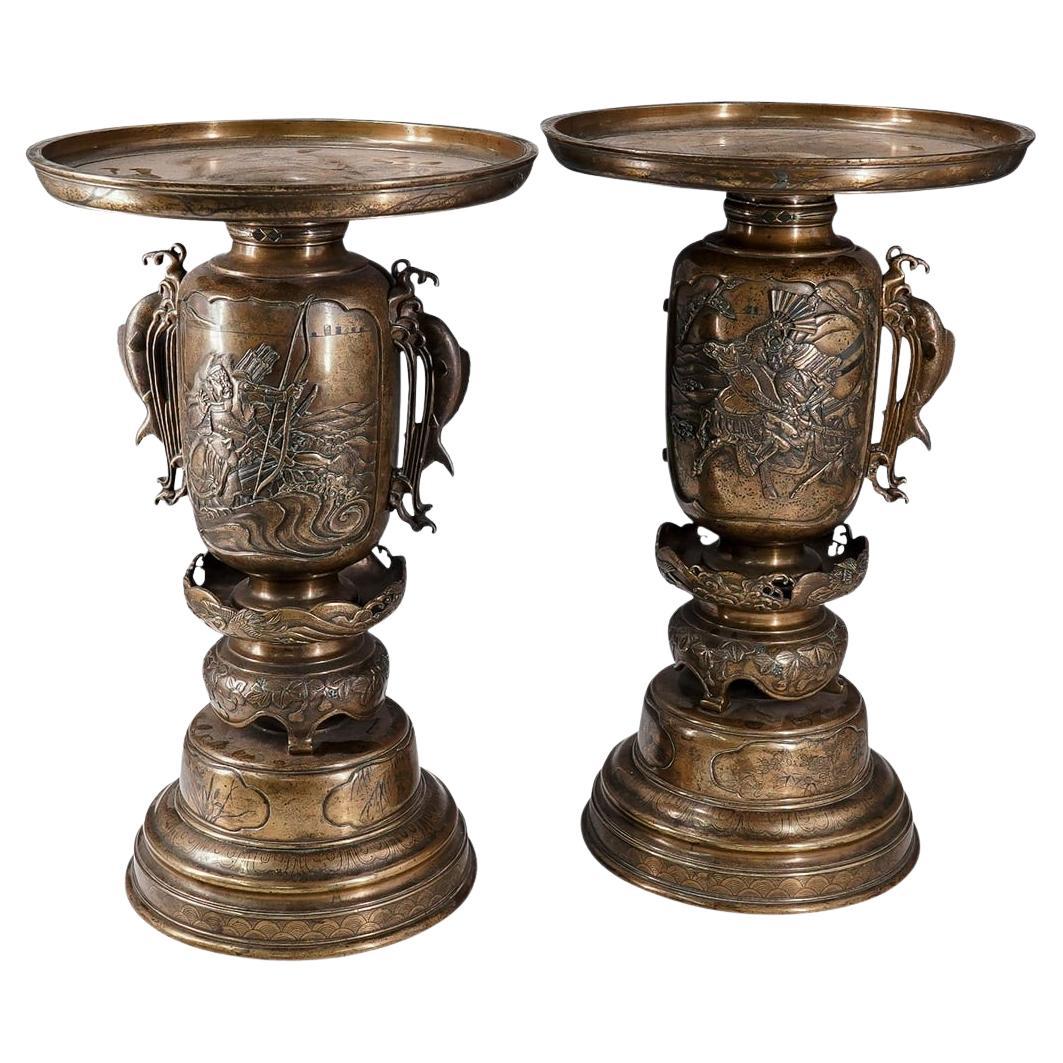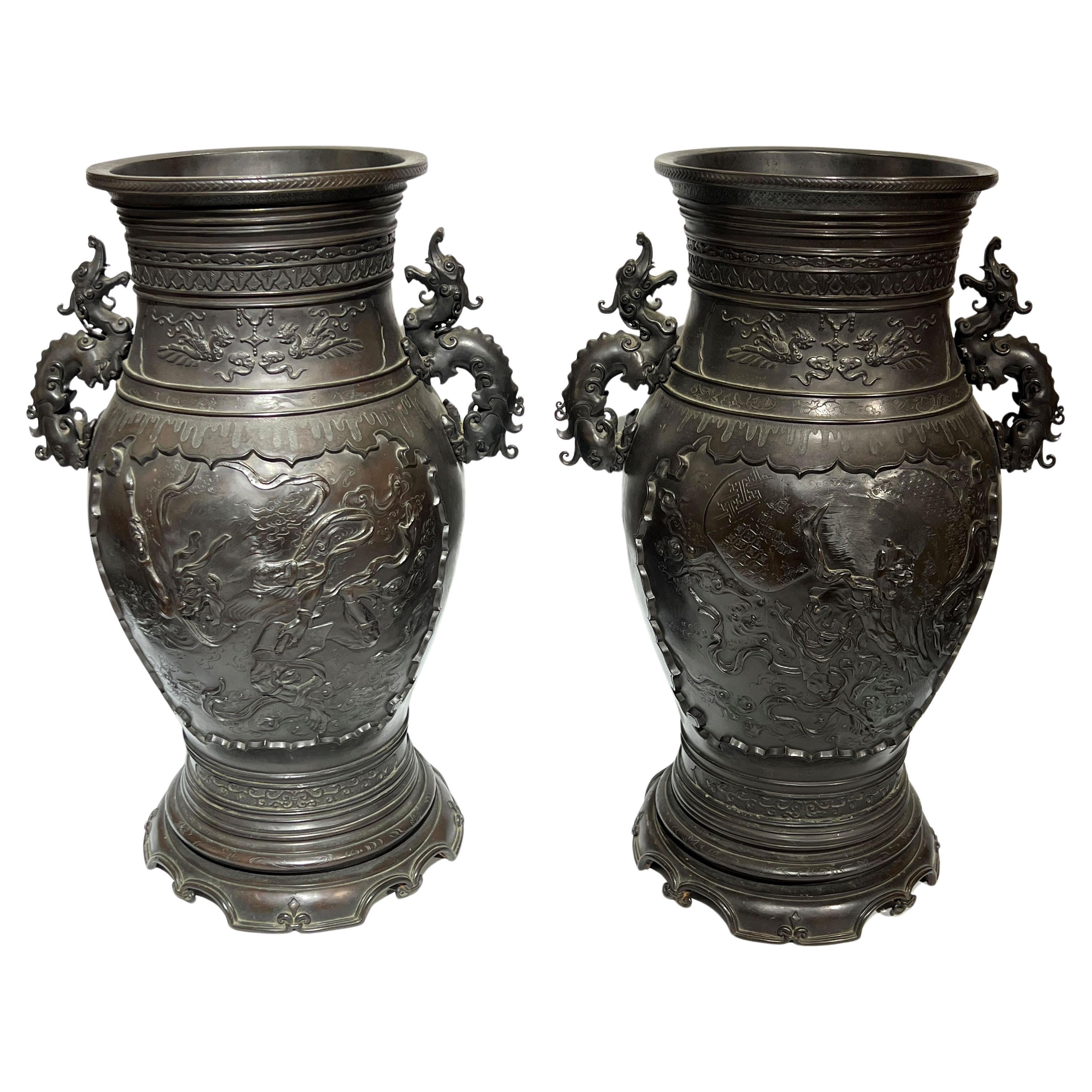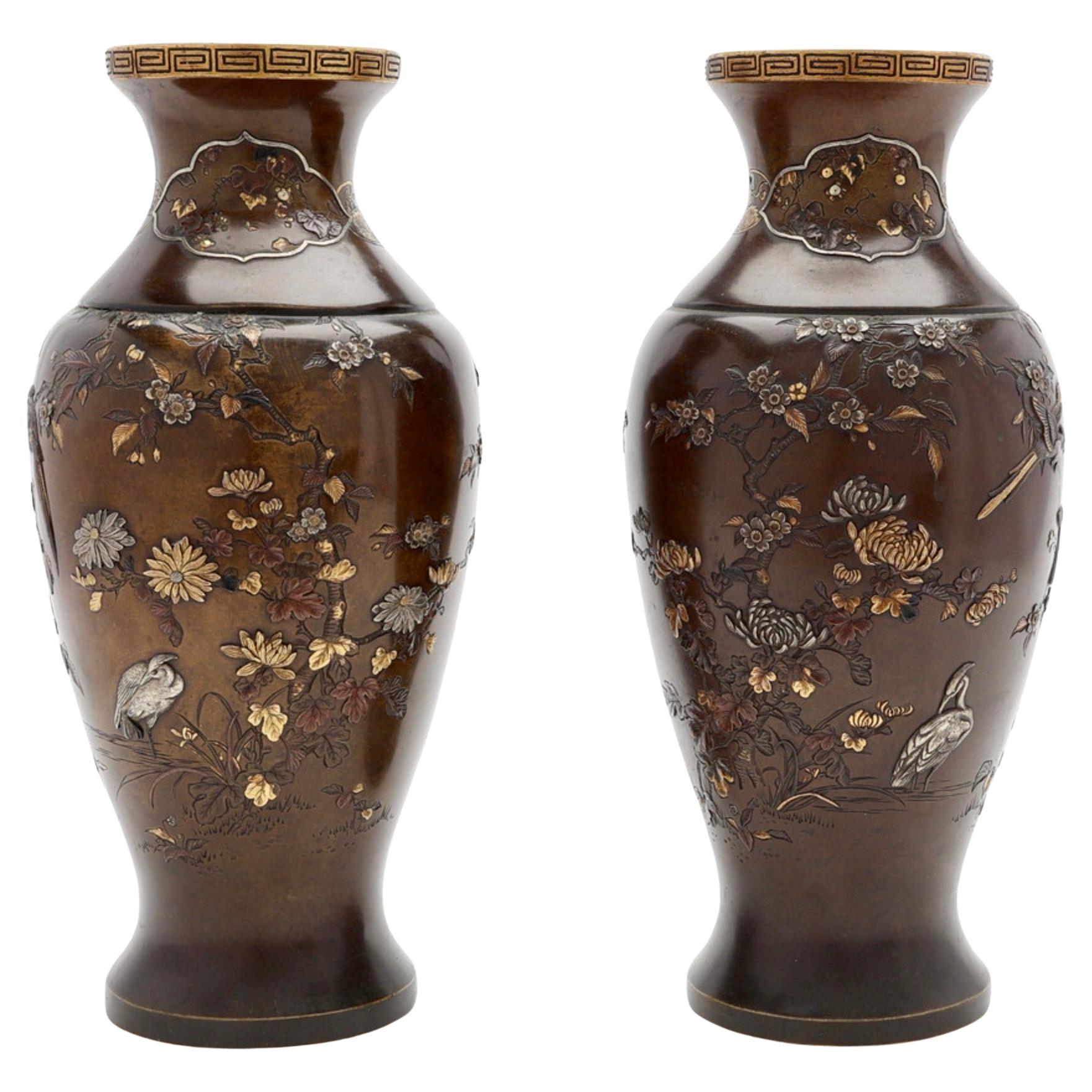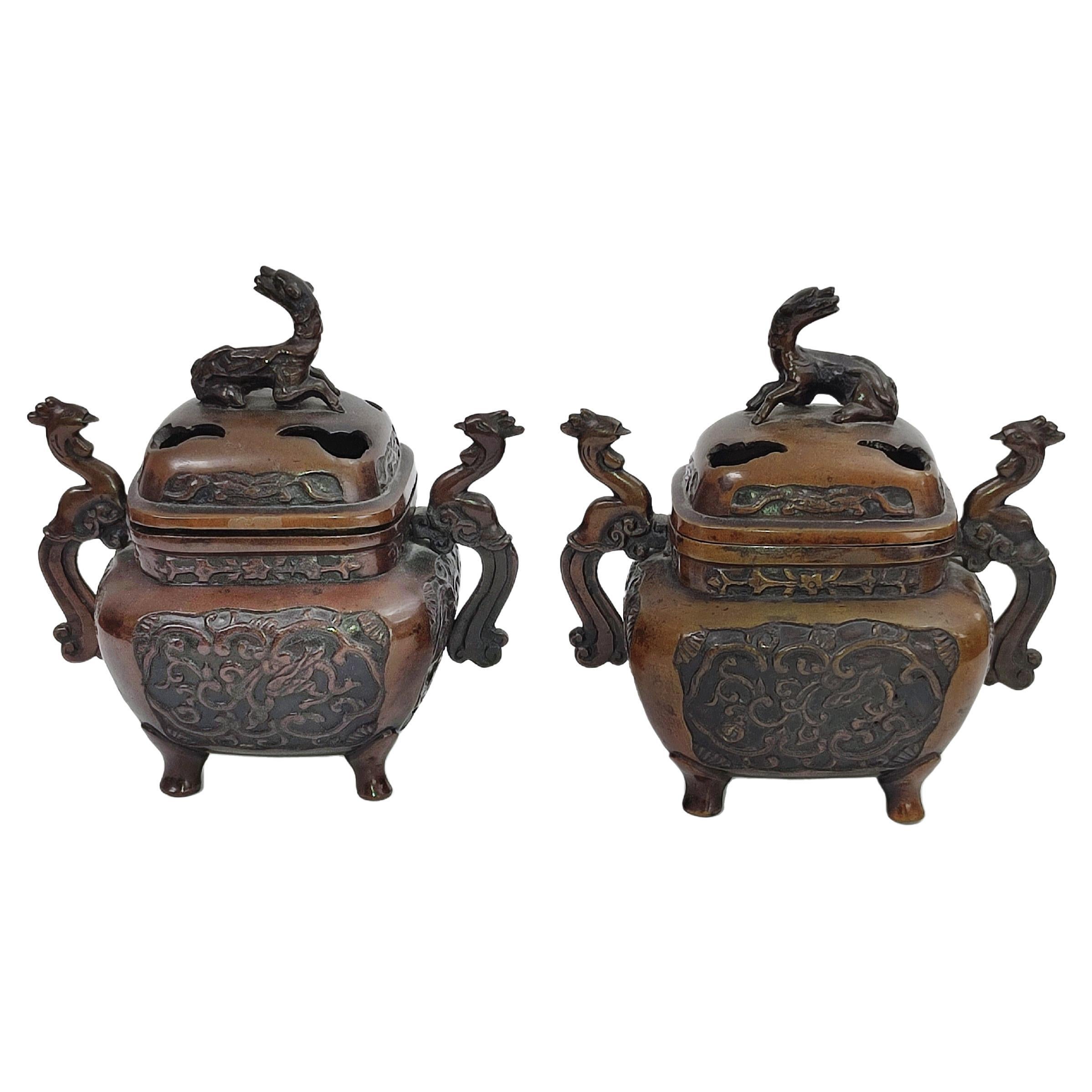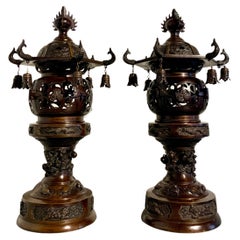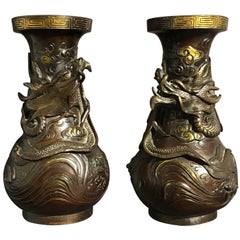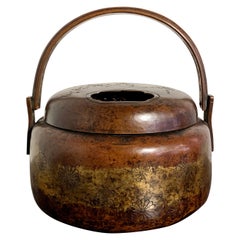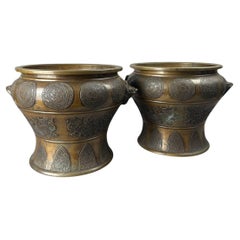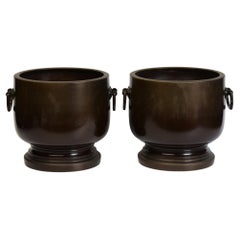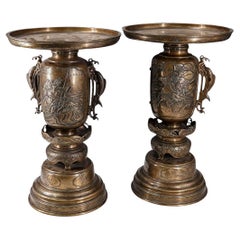Items Similar to Pair of Japanese Bronze Hibachi with Silver and Copper Inlay, Meiji Period
Want more images or videos?
Request additional images or videos from the seller
1 of 13
Pair of Japanese Bronze Hibachi with Silver and Copper Inlay, Meiji Period
$4,950per set
£3,784.54per set
€4,359.02per set
CA$6,936.47per set
A$7,743.91per set
CHF 4,057.69per set
MX$94,793.11per set
NOK 51,532.76per set
SEK 48,588.85per set
DKK 32,531.84per set
Shipping
Retrieving quote...The 1stDibs Promise:
Authenticity Guarantee,
Money-Back Guarantee,
24-Hour Cancellation
About the Item
An exquisite pair of Japanese mixed metal bronze hibachi with idyllic landscape scenes, Meiji period (1868-1912), late 19th or early 20th century, Japan.
The hibachi of generous proportions, with a high, slightly splayed foot, a short, narrow waist, and a large and wide cylindrical body. The body decorated in the mixed metal technique. The bronze carved and set with inlays of copper and silver to create wonderful landscape scenes. A pair of animal mask handles to the sides. Each hibachi with a cast signature reading ?? (Toyomi?) to the underside.
One side of each hibachi depicting an evening scene, with scholars walking about a mountain retreat, replete with a waterfall, pavilions, pagodas, and pine trees, all shimmering under a full moon.
The other side of the hibachi depicting a daytime scene, with a view of similar pavilions, pagoda, and pine, though with boats also visible in the distance.
Copper inlay has been used for the roofs and the trunks of the pine trees. Silver inlay has been used for the pine needles, scholars, building supports, water, boats, moon, as well as the distant mountains.
Originally used as a simple and elegant space heater, in which the hibachi was filled with sand or ash, and hot coals placed on top, today, they make wonderful jardinières or planters.
- Dimensions:Height: 10 in (25.4 cm)Width: 13.75 in (34.93 cm)Depth: 10.5 in (26.67 cm)
- Sold As:Set of 2
- Style:Meiji (Of the Period)
- Materials and Techniques:
- Place of Origin:
- Period:
- Date of Manufacture:circa 1900
- Condition:Wear consistent with age and use. Minor fading. Some tarnishing to the silver in the recessed areas. The bronze with some scattered light staining, as seen in photos. The interior with signs of use, as expected.
- Seller Location:Austin, TX
- Reference Number:1stDibs: LU894722296022
About the Seller
5.0
Platinum Seller
Premium sellers with a 4.7+ rating and 24-hour response times
Established in 2001
1stDibs seller since 2010
345 sales on 1stDibs
Typical response time: <1 hour
- ShippingRetrieving quote...Shipping from: Austin, TX
- Return Policy
Authenticity Guarantee
In the unlikely event there’s an issue with an item’s authenticity, contact us within 1 year for a full refund. DetailsMoney-Back Guarantee
If your item is not as described, is damaged in transit, or does not arrive, contact us within 7 days for a full refund. Details24-Hour Cancellation
You have a 24-hour grace period in which to reconsider your purchase, with no questions asked.Vetted Professional Sellers
Our world-class sellers must adhere to strict standards for service and quality, maintaining the integrity of our listings.Price-Match Guarantee
If you find that a seller listed the same item for a lower price elsewhere, we’ll match it.Trusted Global Delivery
Our best-in-class carrier network provides specialized shipping options worldwide, including custom delivery.More From This Seller
View AllPair Japanese Bronze Pagoda Temple Lanterns, Taisho Period, circa 1920, Japan
Located in Austin, TX
An elegant pair of Japanese cast and lacquered bronze pagoda lanterns, Taisho Period, circa 1920, Japan.
The lanterns a true pair, with mirrored decorations and lantern doors opening in opposite directions. The lanterns of traditional toro form, cast in bronze, and lacquered. Each lantern comprised of three parts - the "roof", the "fire box", and the pedestal. This type of pedestal lantern is called a dai-doro, as opposed to the hanging lantern type, tsuri-doro.
The hexagonal roof of the lantern, reminiscent of temples or pagodas, features a wonderful, dense cloud pattern with three heart-shaped cutouts, known as inome, or boar's eye. The roof topped by a hoju, the Buddhist flaming Jewel of Wisdom. Each of the six corners feature a fantastic shachihoko, mythical beasts with the face of a tiger and body of a fish. Bells are suspended from the shachihoko.
The globular body of the lantern features four pierced panels with the three leaf hollyhock mon of the Tokugawa clan surrounded by a karakusa pattern of scrolling vines. One panel serving as a hinged door with a lock stylized as the Three Jewels...
Category
Vintage 1920s Japanese Taisho Lanterns
Materials
Bronze
Pair of Korean Goryeo Dynasty Bronze Pedestal Bowls, 13th-15th Century, Korea
Located in Austin, TX
An exquisite pair of Korean bronze pedestal offering bowls, Goryeo Dynasty, 13th-15th century, Korea.
The Goryeo bronze bowls of generous proportions, with high sides and an ever so slightly everted rim. The bowls are supported on a pedestal base with a tall stem and wide, splayed ring foot.
The bowls plain, save for a single engraved line circumscribing the splayed foot.
The bowls with an amazingly rich and complex patina of mottled reddish browns from cuprite and dark greens from malachite. The bronze heavily cleaned to the European taste, removing most of the encrustations. Some areas of the bowls with rougher areas where the accretions could not be removed.
Crafted in two parts in the spun bronze technique, then joined. The bowls are unusually thin for bronze, with the lathe lines still visible to the undersides.
An unusual form and size for Goryeo period bronze utensils...
Category
Antique 15th Century and Earlier Korean Metalwork
Materials
Bronze
Pair of Japanese Edo Period Parcel-Gilt Bronze Dragon Vases, Early 19th Century
Located in Austin, TX
A pair of well cast and dramatic Japanese parcel gilt bronze dragon vases, Edo period, early 19th century. The heavy bronze vases of pear shape, each with a single writhing dragon cast in high relief...
Category
Antique Early 19th Century Japanese Edo Metalwork
Materials
Bronze
Japanese Parcel Gilt Copper Hibachi, Edo Period, 18th Century, Japan
Located in Austin, TX
A sublime Japanese parcel gilt copper hand warmer, hibachi, with chrysanthemum design, Edo Period, 18th century, Japan.
The hand warmer, called a...
Category
Antique 18th Century Japanese Edo Metalwork
Materials
Copper
Pair Japanese Cloisonne Dragon and Phoenix Jardinieres, Meiji Period
Located in Austin, TX
A lovely pair of Japanese chakinseki, tea dust, cloisonne jardinieres, Meiji Period, circa 1900, Japan.
The jardinieres each with a squat globular body, short neck, and wide, everted mouth. The bodies decorated wide lappets of mottled puce featuring alternating dragons and phoenixes...
Category
Antique Early 1900s Japanese Meiji Planters, Cachepots and Jardinières
Materials
Copper, Enamel
Assembled Chinese Late Yuan / Early Ming Dynasty Bronze Garniture
Located in Austin, TX
Consisting of a large baluster vase (H: 14.25") with arrow handles and a near pair of smaller baluster vases with mythical beast loop handles.
The large vase, of yuhuchunping form, ...
Category
Antique 15th Century and Earlier Chinese Ming Scholar's Objects
Materials
Bronze
You May Also Like
Pair of Rare Edo-Meiji Period Bronze Hibachi with Lion Handles
Located in Fukuoka, JP
This exceptional pair of bronze hibachi (traditional Japanese braziers) dates back to the Edo period and features exquisite craftsmanship with intrica...
Category
Antique 18th Century Japanese Edo Metalwork
Materials
Bronze
Early 20th C., Showa, A Pair of Antique Japanese Old Bronze Hibachi Brazier Pots
Located in Sampantawong, TH
A pair of Antique Japanese old bronze Hibachi brazier pots.
Hibachi is a traditional Japanese heating device.
Age: Japan, Showa Period, Early 20th Century
Size: Height 26.4 C.M. / ...
Category
Early 20th Century Japanese Antiquities
Materials
Bronze
$1,280 Sale Price / set
20% Off
Pair 19th Century Meiji Japanese Usabata Ikebana Bronze Vases
Located in New York, NY
Pair of antique (late 19th century) Meiji period Japanese usabata ikebana vases crafted in four sections and measuring an impressive 18 3/4 inches tall. Each with cartouches depicti...
Category
Antique Late 19th Century Japanese Meiji Metalwork
Materials
Bronze
Pair Large Meiji Japanese Bronze Vases
Located in New York, NY
Pair of very fine Meiji period Japanese bronze vases with dark brown patina with dragon handles and exceptional designs of grotesque mythological figures. 23 1/4 inches tall and eac...
Category
Antique Late 19th Century Japanese Meiji Metalwork
Materials
Bronze
$7,500 / set
Pair of Japanese urns. 19th c. Meiji period. Signed.
Located in Stockholm, SE
These pair of Japanese bronze urns from the Meiji period have decorations of birds and flowers. The inlays are made of silver, gilt bronze and shakudo. Both urns are signed at the bo...
Category
Antique Late 19th Century Japanese Metalwork
Materials
Bronze
Pair of Vintage Asian Bronze Incense Burners , Koro
Located in Bochum, NRW
Pair of vintage Asian bronze incense burners
A pair of bronze censers with lids, handles, and knobs as mythological animals, China circa 1...
Category
Early 20th Century Chinese Metalwork
Materials
Bronze
More Ways To Browse
Copper Inlay
Japanese Roof
Japanese Bronze Animals
Copper And Silver Inlay
Bronze Pagoda
Cast Bronze Planter
Cylindrical Planter
Large Japanese Planter
Copper Boat
Meiji Bronze Animal
Antique Copper Cylinder
Cast Metal Planter
Japanese Bronze Planter
Japanese Bronze Jardiniere
Japanese Hibachi
Japanese Bronze Silver Inlay
Meiji Mixed Metal
Japanese Meiji Period Mixed Metal
